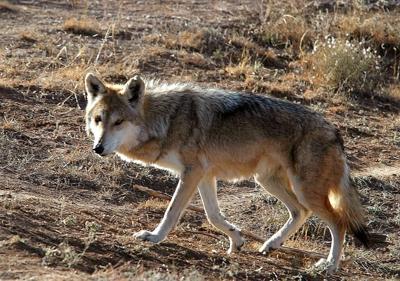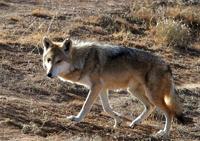ALBUQUERQUE, N.M. (AP) — Environmentalists want the U.S. government to list coyotes as endangered in parts of Arizona and New Mexico where the rarest subspecies of gray wolf in North America is found.
A coalition of groups argue in a submitted Thursday to U.S. Interior Secretary Deb Haaland and the U.S. Fish and Wildlife Service that small statured Mexican gray wolves are often mistaken for coyotes and that protecting coyotes would in turn cut down on wolf deaths.
Environmentalists say illegal killings are the leading cause of death for the endangered animals.
The petition pointed to cases in which Mexican wolves have been killed by people who said they believed they were killing a coyote. This misidentification invokes a federal policy that effectively protects a person from prosecution because it requires the government to prove that a defendant knew they were killing an endangered species when they pulled the trigger.
“It’s an outrage that merely saying ‘I thought it was a coyote’ serves as a get-out-of-jail-free card for anyone who shoots one of these highly imperiled animals,” said Michael Robinson with the Center for Biological Diversity.
Ranchers argue there are more Mexican wolves roaming the Southwest now than any time since recovery began more than two decades ago, and that rural communities continue to bear the costs of livestock losses due to wolf reintroduction.
Loren Patterson, president of the New Mexico Cattle Growers’ Association, said Thursday that his group learned last week that Mexican wolves were located north of Interstate 40 as well as in the Manzano Mountains near Albuquerque.
As the wolf population expands, more human interaction and incidental wolf deaths should be expected, Patterson said.
“To hamper our recreational and agriculture communities by protecting an unregulated furbearer is unjustified,” he said. “The livestock industry is still not being made whole by wolf depredations and to add the inability to control problem coyote populations would just add to a tense situation between the endangered species and the people that live within the recovery zone.”
He suggested real-time location maps of collared wolves, hunter education and reimbursing the full value of livestock killed by wolves would be better options for addressing the problem.
While the petition acknowledges that it’s unknown how many Mexican gray wolves are killed in cases of real or alleged mistaken identity, the environmental groups argue that publications and posters encouraging hunters to learn the difference haven't helped.
There are at least 196 Mexican gray wolves in the wild in New Mexico and Arizona, according to . It marked the sixth straight year the population has increased.
Under the Endangered Species Act, federal wildlife officials can make a determination to protect a species that is neither endangered nor threatened when it closely resembles an endangered or threatened species.
A key consideration would be the degree of difficulty wildlife agents and other enforcement personnel would have in distinguishing the species. The petition points to a case in 2013 in which a wildlife specialist shot and killed a wolf, thinking it was a coyote.
Coyotes can be hunted year-round in Arizona and New Mexico with no requirement for a hunting license.
Republican Sen. Crystal Diamond of Elephant Butte raised her daughters on a ranch in wolf territory and she said she knows firsthand about the challenges facing southwestern New Mexico. She called the coyote proposal absurd, saying environmentalists have been trying to weaponize the Endangered Species Act and that such proposals make it more difficult to find a middle ground.
“What this does is further discredit the value and the intent of what the Endangered Species Act was created to do,” she said.
The Fish and Wildlife Service must decide whether to consider the petition.








































